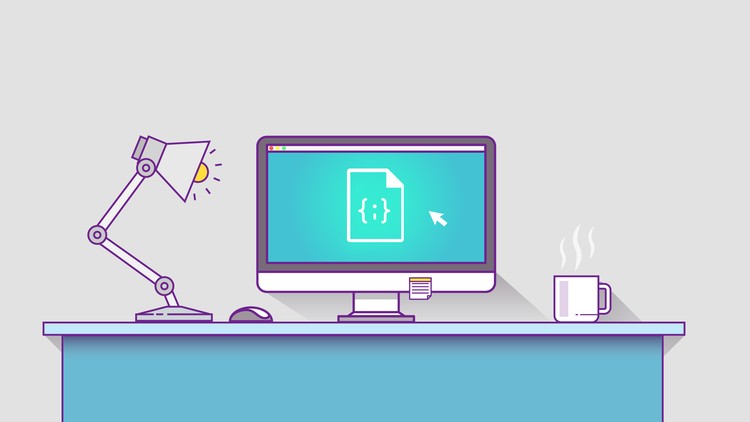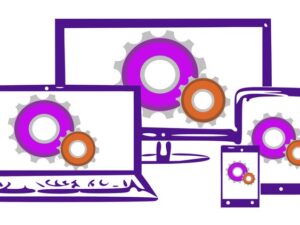Java Tutorial for Complete Beginners
- Description
- Curriculum
- FAQ
- Reviews
- Grade

Learn to program in the Java programming language. This course assumes no prior programming knowledge, just a desire to learn to program.
-
1Introduction and InstallationIntroducing the Java for Complete Beginners course, and what you need to install in order to get started. Don't worry too much about what this stuff we're installing actually does --- we'll look at that next time.
-
2What Java Is and How It WorksIn this tutorial we'll talk about such things as the Java Virtual Machine and the Java Development Kit; we'll discuss what a programming language is exactly, and how you basically make your computer do stuff.
-
3Getting a Job and What to Study After Completing Basic JavaWhat should you do when you've completed a basic Java course, and can you get a job with Java? In this video I'll explain a bit about some of the major areas of advanced Java, the process of finding a job and what you might want to study next, once you've completed basic Java.
-
4How To Get The Most Out Of This CourseSome ideas about how best to learn Java and how to work through this course.
-
5A Hello World Program
Create a simple Java program with Eclipse.
-
6Using Variables
Variables are one of the most basic essential building blocks of computer programs. We'll take a look at Java's basic types of variables here.
-
7Strings: Working With Text
The String class allows you to work with text in Java.
-
8While Loops
In this tutorial we'll look at how to create loops in your code so that you can execute the same lines of code repeatedly.
-
9For Loops
"For" loops allow you to control exactly how many times your loop executes.
-
10"If"
-
11Getting User Input
A tutorial on how to get user input in your program using the Scanner class.
-
12Do ... WhileHow to use do...while loops in Java, plus variable scope and multi-line comments. I take a look at a solution to a commonly-assigned beginner's exercise in Java.
-
13SwitchThe switch statement lets you choose between multiple alternatives.
-
14ArraysHow to use arrays in Java; creating, accessing and iterating through arrays. Also, a look at the difference between a value and a reference.
-
15Arrays of StringsA tutorial on arrays of Strings in Java, plus another way to iterate through an array, and more stuff on the difference between values and references.
-
16Multi-Dimensional ArraysHow to work with multi-dimensional arrays in Java and info on how multi-dimensional arrays actually work, plus some tips on how to remember which index is which.
-
17Classes and ObjectsIt's finally time to take a look at classes and objects, the main building blocks of OO (Object Oriented) programming.
-
18Methods
Classes (and objects) can contain data and subroutines, the latter being referred to as "methods". We'll look at methods here.
Note: there's a little error right at the end here -- I copied person1.sayHello() but didn't change it to person2 ..
-
19Getters and Return ValuesIn this tutorial we'll look at returning values from methods, including the standard "get method", "getter" or "accessor" form.
-
20Method ParametersWe've already covered returning values from methods; now we'll take a look at passing values to methods. These two techniques allow you, among other things, to create methods that process one piece of data into another ...
-
21Setters and "this"Setters (or set methods, or, if you have come from the 1970s in a time machine, "mutators"), allow you to change the data in your objects. We'll also take a look here at the "this" keyword.
-
22ConstructorsConstructors are a special kind of method that gets run automatically when you create an object from a class (or in the lingo, "instantiate" an object).
-
23Static (and Final)A tutorial on the static keyword in Java. We'll also take a look at "final".
-
24String Builder and String FormattingIt's time to take a closer look at the important topic of formatting and combining strings ....
-
25The toString MethodtoString() is a method of the Object class, which is the ultimate parent of all objects in Java. By over-riding it, you can implement a way to create a string representation of your object.
-
26InheritanceInheritance is one of the basic building blocks of OO programs. And yes, believe it or not, it is actually used in the real world -- constantly -- but perhaps most often when working with elaborate external APIs, such as Swing or servlets.
-
27PackagesPackages allow you to organise your Java code, in a hierarchical structure exactly like the folder structure on your computer.
-
28InterfacesInterfaces are a vital tool in Java programming. At first you may be tempted to suspect that people only use them to show off their Java skills; but once you understand fully what they do, you won't want to do without them. Trust me on this one ...
-
29Public, Private, ProtectedPublic, private and protected are Java keywords that allow you to implement "encapsulation" -- hiding away the internal mechanism of your classes, while exposing only certain selected methods the rest of your program.
-
30PolymorphismPolymorphism means being able to use a child class wherever a parent class is expected. For example, if you want to use a class of type Animal, you can always use a class of type Dog instead (if Dog extends Animal).
-
31Encapsulation and the API DocsEncapsulation is the art of hiding away the workings of a class and only exposing a public API. We'll also take a look at how to read the API docs.
-
32Casting Numerical ValuesLet's take a look at how to change one kind of number into another.
-
33Upcasting and DowncastingUpcasting and downcasting really test your understanding of Java references and objects. If you can understand this stuff (and yes, it's also very useful aside from testing your understanding), then you've definitely got the aptitude to make a great programmer. And if you CAN'T understand it, then stick at it :)
-
34Using GenericsGenerics allow you to use and create classes that work with objects, the type of which you can specify when you use "new".
-
35Generics and WildcardsIf you want to pass templated objects to methods, you might want to make use of some interesting syntax ....
-
36Anonymous ClassesAnonymous classes look a bit weird at first, but they can really help to streamline your code.
-
37Reading Files Using ScannerThe easiest way to read a text file is by using the Scanner class. We'll take a look at Scanner in this tutorial. Scanner basically just parses an input stream (a sequence of bytes, in other words) into lines or tokens, but it will open a file for you too if you ask it the right way.
-
38Handling ExceptionsIt's finally time to start looking at exceptions .... A major component of the Java language, and one that you're bound to run across in any sizeable program. Here we'll look at the two ways of handling exceptions and how they work.
-
39Multiple ExceptionsYou can throw more than one possible type of exception from a method, and you can catch multiple exceptions in your try-catch block We'll look at the possibilities here, and also take a look at a common interview/exam question.
-
40Runtime vs. Checked ExceptionsSo far we've looked at checked exceptions; the kinds of exception that you are forced to handle. But there are also unchecked (runtime) exceptions. These are exceptions that you can handle if you want to, but you're not forced to. Knowing about the two main kinds of exception is considered an important test of knowledge in Java.
-
41Abstract ClassesAbstract classes allow you to define the parent class of a new hierarchy without having to worry about the user actually instantiating the parent. For instance you could create an "Animal" class just to act as the basis for "Dog", "Cat, "Sheep" and so on, even defining some functionality in "Animal", but at the same time preventing the user of your hierarchy from trying to create an "Animal" object (which after all wouldn't make much sense -- you never encounter an abstract "animal" in the real world; only particular kinds of animals).
-
42Reading Files With File ReaderTo really get serious about reading files in Java, you need to get used to stacking objects inside each other like Russian dolls. Although the code we'll examine here is complex, in the next tutorial we'll discover a Java 7 language feature that can simplify it a lot. It's also a very flexible structure for reading files, since you can read different kinds of files by changing a class or two.
-
43Try-With-ResourcesThe Java 7 Try-With-Resources syntax can massively simplify your file reading/writing code.
-
44Creating and Writing Text FilesA tutorial on writing text files. Which is very similar to reading text files.
-
45The Equals Method
A tutorial on how to implement the .equals method for your own classes.
-
46Inner ClassesClasses can be declared almost anywhere in Java. In particular, it's often very useful to declare either static or non-static classes within other classes.http://www.caveofprogramming.com/java/inner-classes/
-
47Enum Types: Basic and Advanced UsageThe enum keyword lets you create constants that belong to a fixed set of values (think colours, animals, etc). In the first half of this video we'll look at basic usage and why we need enum, then we'll move on to more advanced usage.Source code: http://www.caveofprogramming.com/java/enum/
-
48Recursion: A Useful Trick Up Your SleeveRecursion is a programming technique that allows you to solve certain kinds of problems very elegantly. It involves calling a method from itself. Crazy!Source code: http://www.caveofprogramming.com/java/recursion/
-
49Serialization: Saving Objects to FilesSerialization is the process of turning objects into a stream of binary data; by serializing objects, you can store them in a file and restore them later from the same file, implementing saving and loading in your application.
-
50Serializing Arrays
We can serialize entire arrays (or ArrayLists) just as easily as single objects. I'll also show you a good trick for serializing multiple objects individually in this tutorial, plus we'll talk a bit about type erasure.
-
51The Transient Keyword and More Serialization
To finish off the stuff about serialization, we'll take a look at the transient keyword, plus a few things that might catch you out.
-
52Passing by Value
Java only supports one method of passing values to methods, unlike, e.g. C++. We'll take a look at exactly how argument passing works in this tutorial (note: source code attached to this lecture; for other lectures, see the source attached to the final lecture).
-
53ArrayList: Arrays the Easy WayThe ArrayList class takes the work out of using arrays, by providing you with a resizeable array object.
-
54Linked Lists
If you want to add items efficiently to somewhere in a list other than the beginning or end, you need a linked list.
IMPORTANT NOTE: I had misunderstood something when making this video, as pointed out to me by "kidbabic" on YouTube among others. If you add or insert something to a LinkedList by specifying an index, the list has to iterate over all items in itself up to that point in order to find the insertion/deletion point. So adding or removing to LinkedList is only faster if you use an iterator, which you have ready pointing at the correct point. See the tutorial on iterators later on for more info.
-
55HashMap: Retrieving Objects via a KeyMaps let you store key-value pairs, so that for example you can retrieve objects via an ID. HashMap is the most lightweight in terms of memory, and the one you'll use the most often.
-
56Sorted MapsIf you want your map keys to be sorted, you can use special kinds of maps. A lot of what we'll cover here also applies to sets, which we'll look at shortly.
-
57SetsUsed less often than lists or maps, sets are nevertheless great for creating collections of things that are unique --- in other words, for removing duplicates. It's also very quick to check whether a value exists in a set, whereas checking for something in a list can take a long time in computer terms.
-
58Using Custom Objects in Sets and as Keys in MapsIf you want to use objects of your own classes in sets, or you want to use them as the keys in maps, you need to do a couple of little things ....
-
59Sorting ListsA common requirement for a list is to sort it in some kind of order. Fortunately Java makes sorting very easy.
-
60Natural OrderingHow will your objects be sorted, if you sort them somehow? The sort order often depends on something called the natural order, and you can define custom natural orders for your own classes to sort them in the order you want.
-
61QueuesQueues are used less often than lists, sets and maps, but they're still very useful; especially if you're doing any multi-threading.
-
62Using IteratorsIterators are the thing that enable you to get each element in a collection in sequence. We'll look at using them in this tutorial, then next time we'll move on to implementing our own.
-
63Implementing IterableIf you implement Iterable, you'll be able to iterate over your own custom collection.
-
64Deciding Which Collection to UseIt's time for a review of how to choose which of the main Collection classes and types to use. In this tutorial we'll go over some stuff we learned earlier and bring it all together.
-
65Complex Data StructuresYou can use "nested" Collections objects to represent all kinds of complicated data structures in Java; maps of lists of sets of maps, etc, etc. We'll take a look at a simple example here, inspired by a university coursework question.
-
66Eclipse ShortcutsMy favourite Eclipse shortcuts.
-
67Getting a Job Extended Version: What you need, a strategy for finding work, and my story.An extended video detailing my strategy for finding a job as a software developer, plus stuff about the question of whether you need experience or a degree, what you can do to increase your chances and my own personal story of how I got into software development.
-
68Ten Tips for Improving Your CodingTen tips that every programmer should know (and hopefully the professionals already do!). These tips WILL, if followed, hugely increase your productivity.
-
69Debugging in EclipseIn this tutorial we'll take a look at using the Eclipse debugger. Debugging is useful for when your program compiles and runs but doesn't do what you expect, and you're having a hard time figuring out why. Debugging allows you to execute the program line by line and to see what values each variable in your program have at each step.












